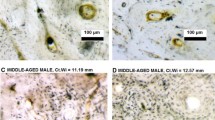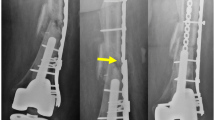Abstract
The upper femur has long held a fascination for both clinicians and bioengineers as it contains two trabecular columns obviously related to its function. In this respect two theories as to the formation of these columns have developed, both associated with Wolff: the Trajectorial Theory, which relates mainly to the passage of forces through the cancellous bone of the upper femur, and Wolff’s Law of bone formation, which describes the bone’s reaction to these forces and relates to bone in general. The two concepts nevertheless are often used synonymously. The Trajectorial Theory propounds that these cancellous structures in the femoral neck are due to both tension and compression forces, while modern day concepts of Wolff’s Law only acknowledge the action of compression forces: and herein lies the paradox. The Trajectorial Theory and Wolff’s Law, when applied to the upper femur, are mutually exclusive. The evidence, anatomical and physiological, indicates that bone forms within the femoral neck solely under the influence of compression forces. This would indicate that the Trajectorial Theory is not appropriate for this region. An alternative conceptual way of looking at this region is presented which eliminates this theory and resolves the paradox.





Similar content being viewed by others
References
Wolff J (1986) The law of bone remodelling (trans: Maquet P, Furlong R). Springer, Berlin
Bertrum JEA, Swartz SM (1991) The ‘law of bone transformation’: a case of crying Wolff? Biol Rev 66:245–273
Enlow DH (1963) Principles of bone modeling. In: Evans FG (ed) American lectures in anatomy. Charles Thomas, Springfield, pp 1–30
Tobin WJ (1955) The internal architecture of the femur and its clinical significance. J Bone Joint Surg Am 37A:57–71
Scott JH (1957) The mechanical basis of bone formation. J Bone Joint Surg Br 39B:134–144
Koch JC (1917) The laws of bone architecture. Am J Anat 21:177–298
Cowin SC (1997) The false premise of Wolff’s Law. Forma 12(3,4):247–262
Turner CH (1992) On Wolff’s Law of trabecular architecture. J Biomech 25:1–9
Fetto J, Leali A, Moroz A (2002) Evolution of the Koch model of the biomechanics of the hip: clinical perspective. J Orthop Sci 7:724–730
Rybicki EF, Simone FA, Weis EB (1972) On the mathematical analysis of stress in the human femur. J Biomech 5:203–215
Carter DR, Orr TE, Fyhrie DP (1989) Relationship between loading history and femoral cancellous bone architecture. J Biomech 22:231–244
Goldstein S, Matthews L, Kuhn J et al (1991) Trabecular bone modelling. An experimental model. J Biomech 24:135–150
Van Rietbergen B, Huiskes R, Eckstein F et al (2003) Trabecular bone tissue strains in the healthy and osteoporotic human femur. J Bone Min Res 18:1781–1788
Richmond BG, Wight BW, Grosse I et al (2005) Finite element analysis in functional morphology. Anat Rec 283A:259–274
Rohlmann A, Mosner U, Bergann G et al (1982) Finite element analysis and experimental investigation of stress in a femur. J Biomed Eng 4:241–246
Zannoni C, Mantovani R, Viceconti M (1988) Material properties assignment to finite element models of bone structures: a new method. Med Eng Phys 20:735–740
Keyak JH, Rossi SA, Jones KA et al (1998) Prediction of femoral fracture load using automated finite element modeling. J Biomech 31:125–133
Gomez-Benito MJ, Garcia-Aznar JM, Doblare M (2005) Finite element prediction of proximal femoral fracture pattern under different load. J Biomech Eng 127:9–14
Roger K, Resnick D, Sartoris DJ et al (2005) Computerized tomography of proximal femoral trabecular patterns. J Orthop Res 4:45–56
Kayak JH, Falkinstein Y (2003) Comparison of in situ and in vitro CT scan based finite element model predictions of proximal femoral fracture load. Med Eng Phys 25:781–787
Verhulp E, Van Rietbergen B, Huiskes R (2006) Comparison of micro-level and continuum-level voxel model of the proximal femur. J Biomech 39:2951–2957
Steihl JB, Jacobson D, Carrera G (2007) Morphological analysis of the proximal femur using quantitative computed tomography. Int Orthop 31:287–292. doi:10.1007/s00264-006-0182-z
Wirtz DC, Pandorf T, Portheine F et al (2003) Concept and development of an orthotropic FE model of the proximal femur. J Biomech 36(2):289–293
Blemker SS, Delp SL (2004) Three-dimensional representation of complex muscle architectures and geometries. Ann Biomed Eng 33:661–673
Blemker SS, Asakawa DS, Gold GE et al (2007) Image based musculo-skeletal modeling: applications, advances and future opportunities. J Magn Reson Imaging 25(2):441–451
Huiskes R (2000) If bone is the answer, then what is the question? J Anat 197:145–156
Frieburg AH (1902) Wolff’s Law and the functional pathogenesis of deformity. Anatomy 124:956–972
Cowin S (1989) A resolution restriction for Wolff’s Law of trabecular architecture. Bull Hosp Joint Dis Orthop Inst 49:205–212
Frost HM (1994) Wolff’s Law and bone’s structural adaptations to mechanical usage: an overview for clinicians. Angle Orthod 64:175–188
Frost H (2001) From Wolff’s Law to the Utah paradigm: insights about bone physiology and its clinical applications. Anat Rec 262:398–419
Prendergast PJ, Huiskes R (1995) The biomechanics of Wolff’s Law: recent advances. Ir J Med Sci 164(2):152–154
Ruff C, Holt B, Trinkhaus E (2006) Who’s afraid of the big bad Wolf? “Wolff’s Law” and bone functional adaptation. Am J Physiol Anthropol 129:484–498
Lee TC, Taylor D (1999) Bone remodeling: should we cry Wolff? Ir J Med Sci 168:102–105
Frost HM (1983) A determinant of bone architecture: the minimum effective strain. Clin Orthop Relat Res 175:286–292
Huiskes R (1997) Validation of adaptive bone remodeling simulation models. In: Lowet G et al (eds) Bone research in biomechanics. IOS Press, Amsterdam, pp 33–48
Goodship AE, Lanyon LE, McFie H (1979) Functional adaptation of bone to increased stress. J Bone Joint Surg Am 61A:539–546
Lanyon LE, Baggott DG (1976) Mechanical function as an influence on the structure and form of bone. J Bone Joint Surg Br 58B:436–443
Rubin CT, Lanyon LE (1985) Regulation of bone mass by mechanical strain magnitude. Calcif Tissue Int 37:411–417
Chamay A, Tschantz P (1972) Mechanical influences in bone remodeling; experimental research of Wolff’s Law. J Biomech 5(2):173–180
Pauwels F (1980) Short survey of the mechanical stressing of bone. In: Maquet P, Furlong R (eds) Biomechanics of the locomotor apparatus. Springer, Berlin, pp 478–503
Hart R (2001) Bone modeling and remodeling: theories and computation. In: Cowin SC (ed) Bone mechanics handbook, 2nd edn. CRC Press, Boca Raton, pp 31–41
Huiskes R, Chao EYS (1983) A survey of finite element analysis in orthopedic biomechanics: the first decade. J Biomech 16:385–409
Oxnard CE (2004) Thoughts on bone biomechanics. Folia Primatol 75:189–201
Jansen M (1920) On bone formation. The University Press, Manchester
Garden RS (1961) The structure and function of the proximal end of the femur. J Bone Joint Surg Br 43B(3):576–589
Roesler H (1987) The history of some fundamental concepts in bone biomechanics. J Biomech 20:1025–1034
Roesler H (1981) Some historical remarks on the theory of cancellous bone structure (Wolff’s Law). In: Cowin SC (ed) Mechanical properties of bone. American Society of Mechanical Engineers, New York, pp 27–42
Meade JB, Cowin SC, Klawitte JJ et al (1984) Bone remodeling due to continuously applied loads. Calcif Tissue Int 36(Suppl):S25–S30
Rubin CT, Lanyon LE (1987) Osteoregulatory nature of mechanical stimuli: function as a determinant for adaptive remodeling in bone. J Orthop Res 5:300–310
Kenwright J, White SH (1993) A historical review of limb lengthening and bone transport. Injury 24(Suppl):S9–S19
Ling RSM, O’Connor JJ, Lu T-W et al (1996) Muscular activity and the biomechanics of the hip. Hip Int 6:91–105
Frankel VH (1986) Biomechanics of the hip joint. Instr Course Lect 35:3–9
Dude GN, Heller M, Albingere J et al (1998) Influence of muscle forces on femoral strain distribution. J Biomech 31:841–846
Fraldi M, Esposito L, Perrella G et al (2009) Topological optimization in hip prosthesis design. Biomech Model Mechanobiol. doi:10.1007/s10237-009-0183-0
Carey EJ (1929) Studies in dynamics of histogenesis. J Radiol 13:127–168
St. Clair Strange FG (1965) The hip. Heinemann, London, pp 28–51 (quoted by Ling et al)
Heller MO, Bergman G, Deuretzbacher G et al (2001) Musculo-skeletal loading conditions at the hip during walking and stair climbing. J Biomech 34:883–893
Rudman KE, Aspden RM, Meakin JR (2006) Compression or tension? The stress distribution in the proximal femur. Biomed Eng 5:12. doi:10.1186/1475-925X-5-12
Dixon AF (1910) The architecture of the cancellous tissue forming the upper end of the femur. J Anat Physiol 45:223–230
Backman S (1957) The proximal end of the femur. Acta Radiol Suppl 146:1–166
Hammer A (2010) The structure of the femoral neck: a physical dissection with emphasis on the internal trabecular system. Ann Anat 192:168–177
Shelley FJ, Anderson DD, Kolar MJ et al (1996) Physical modeling of hip joint forces in stair climbing. Proc Inst Mech Eng 210:65–68
Conflict of interest
Dr. Hammer has nothing to disclose.
Author information
Authors and Affiliations
Corresponding author
Rights and permissions
About this article
Cite this article
Hammer, A. The paradox of Wolff’s theories. Ir J Med Sci 184, 13–22 (2015). https://doi.org/10.1007/s11845-014-1070-y
Received:
Accepted:
Published:
Issue Date:
DOI: https://doi.org/10.1007/s11845-014-1070-y




